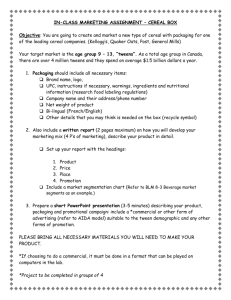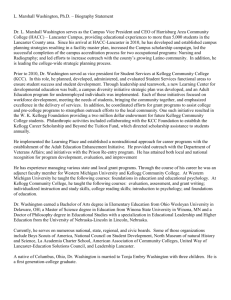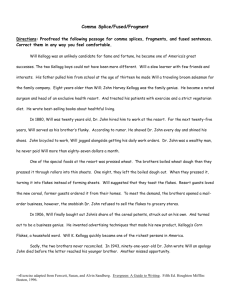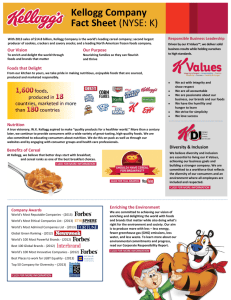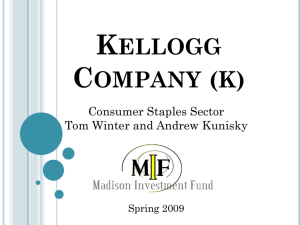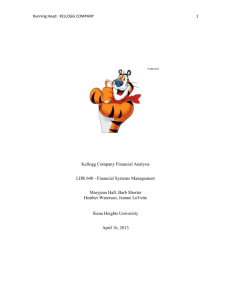Section Notes - Faculty Directory | Berkeley-Haas
advertisement
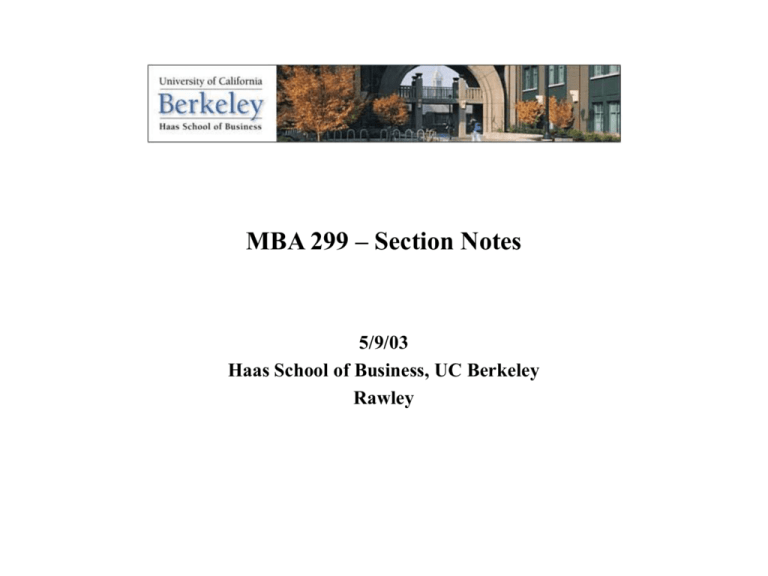
MBA 299 – Section Notes
5/9/03
Haas School of Business, UC Berkeley
Rawley
0
AGENDA
Old exam questions (5-7)
Dominant strategies
Nash equilibrium (NE)
IDSDS
Repeated games and SPNE
Cournot equilibrium
Suggested answers to the conceptual (old) exam questions
1
OLD FINAL EXAM QUESTIONS: #5
Q: Which of the following statements about the inferior technology used by
the fringe firms is correct?
Answer A:
LRAC = $10
Eliminate option D. since if AC and MC are >$10 the fringe would never be
willing to sell at $10
If MC falling at $10 then LRAC is declining, similarly if MC is rising at $10
then LRAC is falling so B. and C. do not make sense as options here
2
OLD FINAL EXAM QUESTIONS: #6
Q: A number of possible marginal revenue curves for the one firm with the
superior technology are also illustrated
Answer D:
MR = dR/dQ
Market demand is not the same as firm specific demand
If this was a monopoly (supply) market then ACEF is the MR curve, but since
there are at least two firms producing here (note the other MR curve at HG),
the market price is $10, after point H the situation is just like the monopoly
situation again . . . therefore MR is flat from B to H and then follows the
“normal” MR curve from E to F
3
OLD FINAL EXAM QUESTIONS: #7
Q: Find the equilibrium set of prices (in a sealed bid auction)
Answer D: 3 NE in this game
Do NOT use IDWDS (as I did in class last week)
2
1
400
401
402
400
0,0
0,0
0,0
401
0,0
½, ½
1,0
402
0,0
0,1
1,1
4
DOMINANT STRATEGIES
Best Strategy Regardless of What the Other Player Does
2
1
2
L
B
R
U
1,0
0,0
0, ½
M
0,0
½, ½
1,1
D
0,0
0,1
0,2
1
L
B
R
U
0,0
0,0
0, ½
M
1,0
½, ½
1,1
D
0,0
0,1
0,2
2 has a DS {R}, but 1 does not
so there is no solution in DS
2’s DS is R, 1’s DS is M so the
solution in DS is (M,R)
notice that MR is a NE
notice that MR is a NE too
5
NASH EQUILIBRIUM
Best Response Given the Other Player’s Strategy
2
1
2
L
B
R
U
1,1
0,0
0, ½
M
0,0
½, ½
1,0
D
0,0
0,1
0,2
2 Nash Equilibria (U,L) and
{B,M}
1
L
B
R
U
1,1
0,0
0, ½
M
0,99
D
0,0
½, ½ 100,98
0,1
99,99
NE is {U,L}
Notice this outcome is not
efficient
Every game has a NE
6
ITERATED DELETION OF STRICTLY DOMINATED
STRATEGIES (IDSDS): Problem #4 P.S. #1
Eliminate Strategies That Will Never Be Played in EQM
2
1
L
R
U
8,5
2,4
M
5,4
6,3
D
4,1
4,8
First eliminate row D, next
eliminate column R
Solution in IDSDS is also a NE
7
REPEATED GAMES & SPNE
Credible Threats Can Shift the EQM in a Repeated Game
2
If each player believes the other
player will punish them with the
lower NE in stage 2 if they fail to
play C or M in stage 1 (respectively)
1
then the unique SPNE in this stage
game played twice without
discounting is (M,C), (D,R)
L
C
R
U
1,1
5,0
0,0
M
0,5
4,4
0,0
D
0,0
0,0
3,3
Note: Stage game NE underlined here
8
PROBLEM SET #2 QUESTION 1: COURNOT EQM (I)
Q(p) = 2,000,000 - 50,000p
MC1 = MC2 = 10
a.) Find the Cournot EQM
P(Q) = 40 - Q/50,000
Find each firm’s mutual best response
i = qi[P(Q)-c] = qi[40 – Q/50,000 -10] = qi[40 – [qi+qj]/50,000 -10] = j
For both firm’s their best play is to maximize profit, therefore take the
derivative of the profit function and set it equal to zero
d i/dqi = 40qi –[qi2 + qiqj]/50,000 – 10qi
= 40 – [2qi + qj]/50,000 – 10 = 0
=> 2qi + qj = 1,500,000 => 3qi = 1,500,000
q1=q2=500,000
9
PROBLEM SET #2 QUESTION 1: COURNOT EQM (II)
b.) What is the profit for each firm in EQM?
i = (p-c)*qi = (40-1,000,000/50,000-10)*500,000 = $5M
c.) What is the monopoly profit level?
Setting MR = MC
MR = dP(Q)/dQ*Q + P(Q) = -Q/50,000 + 40 - Q/50,000 = 40 –Q/25,000
MC = 10
40 –Q/25,000 = 10
Q = 750,000
P = $25
=> m = (25-10)*750,000=$11.25M
10
SUGGESTED ANSWERS TO SHORT ANSWER
QUESTIONS: Question #11 (I)
Warning: These are Evan’s Answers Not Professor Hermalin’s
Part a.) Two possible reasons why Tartot cards are $5 and palm reading $1
Physical barrier to entry: The capital outlay required for Tarot cards
represent a barrier to entry (BTE). Street vendors tend to face borrowing
constraints so capital outlays can be important BTE. As with any BTE,
restrictions on entry allow the owners of the assets to “permanently” increase
price above long-run average cost.
Human capital barrier to entry: While anyone can sound credible reading a
palm sounding credible when reading Tarot cards might take some
specialized investment in human capital. In this context we view tarot card
readers as “prepared” types and palm readers and “unprepared” types where
prepared types earn rents for erecting human capital barriers to entry.
11
SUGGESTED ANSWERS TO SHORT ANSWER
QUESTIONS: Question #11 (II)
Warning: These are Evan’s Answers Not Professor Hermalin’s
Part b.) Sensible strategies for Farrell and Saloner
Because intellectual property (IP) cannot be used as the basis of sustainable
competitive advantage F & S will drive profit to zero through a form of Bertrand
competition if they do not coordinate on either price or R&D spend dimensions.
Explicitly coordinating on price is illegal, tacit collusion, however, may be possible
since this is duopoly competition in a repeated game. If F & S could send each other
credible signals that deviation from a cooperative outcome (say cost +x%) would be
punished in future rounds (with say marginal cost pricing) it may be possible to sustain
equilibrium prices above marginal cost.
Coordinating on R&D is another solution. F & S could form a joint venture to manage
all R&D activity where the R&D entity was paid cost plus a x% markup. F & S could
then take the (same) raw technology and compete against one another for contracts on
the basis of implementation efficiency.
12
SUGGESTED ANSWERS TO SHORT ANSWER
QUESTIONS: Question #11 (III)
Warning: These are Evan’s Answers Not Professor Hermalin’s
Part c.) Katz-Shapiro network cards
Since the nature of KS’s product is networking KS’s installed base acts a network
externality, or a demand side economy of scale, which supports its dominant market
position. However, KS earns most of it’s profits from services supporting it’s network
software, therefore it is potentially vulnerable to competition over services. Therefore
KS uses leasing to 1. prevent resale of it’s (used) technology and to 2. build switching
costs against entrants into the services segment.
To the first point note that KS faces no other software competition in this segment so it
is particularly interested in forestalling competition from itself. With regard to point 2.
KS faces competition over services so it uses leasing to create barriers to entry. Leasing
network cards as opposed to selling them outright creates switching costs for the lessee
if they move to a new services vendor in the form of three work days per computer.
The desire to avoid switching costs makes customers willing to pay more for KS’s
services than they would to a competitor of KS.
13
SUGGESTED ANSWERS TO THE CASE QUESTION:
Question #14 Part a (I)
1. Suppliers
4. Substitutes
Commodities: sugar, grains etc.
not dangerous
3. Competitors
Company
Market only
growing 1%
See next page
for details
•Breakfast bars/sweets
•Fruit/yogurt/healthy stuff
•Coffee Shoppe foods/prepared food
•Skip breakfast
Based on price realization of cereal
(7%) vs. all food at home (13%) and
the CPI (17%) substitutes appear to be
gaining on cold cereal
2. Buyers
(Retailers)
Generally ignored in the
case but we know they are
growing more powerful
2. Buyers
(Consumers)
2 segments: sugar & healthy
5. BTE
Mfg. and marketing scale
Brand
Few technological barriers
14
SUGGESTED ANSWERS TO THE CASE QUESTION:
Question #14 Part a (II)
3. Competitors
Player
Quaker
Ralston Purina
Kellogg
General Mills
General Foods
Other
1987
8%
6%
41%
21%
13%
11%
1990
7%
6%
39%
24%
11%
13%
Change
+1%
-2%
+3%
-2%
+2%
Comment/brand
Oats are growing
TMNT & licensing brands
Corn & Frosted Flakes, Raisin Bran etc.
Cheerios and extensions
PL is growing, eroding price
realization
note: 1% market share is worth $70 million in revenue . . . so the
change in Kellogg’s market share is significant
15
SUGGESTED ANSWERS TO THE CASE QUESTION:
Question #14 Part b
The category is barely growing in spite of the fact that real price realization
has been falling. Furthermore, Kellogg is losing market share. As the #1
player (think Stackelberg) it looks like Kellogg reduced prices less than it’s
competitors because it needs to “reset” the category price equilibrium at a
lower price point to increase category growth. Furthermore, Kellogg appears
to be reducing its price realization relative to it’s direct competitors to
increase market share in the short run . . . perhaps in the hope that it can
retain some of these customers once competitors respond.
Cereal brands are somewhat differentiated but price is clearly a major factor
in the consumer calculus. Therefore, Kellogg’s “defection” from the well
established oligopoly game is likely to lead to price cuts from competitors in
the next “round.”
16
SUGGESTED ANSWERS TO THE CASE QUESTION:
Question #14 Part c
The fact that the market leader is competing on price in an industry where the
oligopoly game is well established is a bad sign for the cold cereal industry since it
implies that profits are at an unsustainable level.
Innovate in new categories: A happier solution for all players would be for Kellogg to
innovate, perhaps by developing new products that address new trends in breakfast
consumption behavior (e.g., breakfast bars), to increase intrinsic demand for its cold
cereal. Extending its products into competing categories might also allow Kellogg to
play the oligopoly game across categories.
Brand development within category: 1. One weakness in Kellogg’s cereal portfolio is in
oats so introducing an oat brand is obvious strategy to consider. 2. General Mills has
been growing faster than the category through brand extensions. This may also be a
good strategy for Kellogg.
Cost cutting is another “obvious” strategy. The problem with cost reduction is, of
course, that it doesn’t help increase demand -- the central issue here.
Other marketing maneuvers could be productive here. For example reducing spend on
promotions of legacy brands in favor of brand building activities like advertising and
new product promotion.
17
